Overview
Developers often face significant coding challenges that can hinder their productivity and efficiency. Kodezi offers a solution by providing an AI observability platform designed to tackle these issues head-on. Key features such as:
- Real-time monitoring
- Automated remediation
- Intelligent alerts
- Seamless integration capabilities
empower developers to enhance their operational efficiency.
By utilizing Kodezi, teams can experience improved system reliability and reduced downtime. Imagine a scenario where automated alerts notify you of potential issues before they escalate, allowing for proactive resolutions. Furthermore, the integration capabilities ensure that your existing workflows remain uninterrupted while benefiting from enhanced observability.
The advantages of using Kodezi extend beyond just immediate fixes; they foster a culture of continuous improvement in software development. As developers leverage these tools, they can focus on producing high-quality code, ultimately leading to greater productivity and satisfaction within their teams.
Are you ready to transform your coding practices? Explore the tools available on the Kodezi platform and take the first step towards a more efficient development process.
Introduction
The rapid evolution of artificial intelligence has significantly altered the landscape of software development, presenting developers with both opportunities and challenges. As organizations strive to maintain operational efficiency and produce high-quality code, the implementation of an AI observability platform becomes increasingly vital.
How do these coding challenges impact your development process? This article explores ten essential features that enhance AI system performance, streamline workflows, and empower developers to confront the complexities of modern coding challenges.
Furthermore, how can these features reshape the way teams manage their AI systems and ensure they remain at the forefront of innovation?
Kodezi | Professional OpenAPI Specification Generator - AI Dev-Tool: Autonomous Codebase Maintenance
Coding challenges can often feel overwhelming for developers. The Kodezi CLI tool emerges as a leading OpenAPI specification generator that transforms codebase maintenance through automation. Unlike conventional tools that merely generate code, this CLI functions as an autonomous overseer, diligently ensuring that code remains clean, compliant, and production-ready over time.
What sets Kodezi apart? Its robust features include:
- Automated code debugging
- Automatic generation of OpenAPI 3.0 specs
- Swagger UI for API documentation and testing
These capabilities are crucial for engineering teams navigating the intricate landscape of codebase management. Furthermore, as W. Edwards Deming stated, 'Quality is everyone's responsibility.' Kodezi CLI stands out as an essential ally in maintaining high-quality software standards.
By utilizing Kodezi, teams can significantly improve productivity and code quality. Imagine the efficiency gains when your code is consistently clean and compliant! Explore the tools available on the Kodezi platform to elevate your coding practices and ensure your software meets the highest standards.
Real-Time Monitoring: Instant Insights into AI System Performance
Developers often face significant coding challenges that can hinder productivity and code quality. The AI observability platform enables real-time monitoring, providing instant insights into AI performance and empowering teams to quickly identify anomalies and performance problems as they occur. This capability is essential for maintaining operational efficiency, allowing swift corrective actions that reduce downtime and enhance overall reliability.
How can Kodezi help in overcoming these obstacles? By integrating real-time monitoring with tools like GitHub and CI/CD pipelines, organizations can leverage an AI observability platform to ensure their AI systems operate at peak efficiency, ultimately driving better outcomes and maintaining a competitive edge in the market. For instance, companies employing real-time monitoring have reported significant improvements in response times, with tech firms experiencing average reductions of up to 30%.
The benefits of using Kodezi extend beyond mere performance enhancements. This AI-powered programming tool automatically analyzes bugs and corrects code, significantly boosting productivity across more than 30 programming languages and IDEs, including Visual Studio Code. This proactive approach not only enhances performance but also fosters a culture of continuous improvement in software development, where timely insights lead to more agile and effective responses to emerging challenges.
As 83% of companies consider AI a top priority in their business strategies, the integration of an AI observability platform with tools like Kodezi becomes essential for leveraging AI technologies to enhance operational efficiency. Are you ready to explore the tools available on the platform and transform your coding practices?
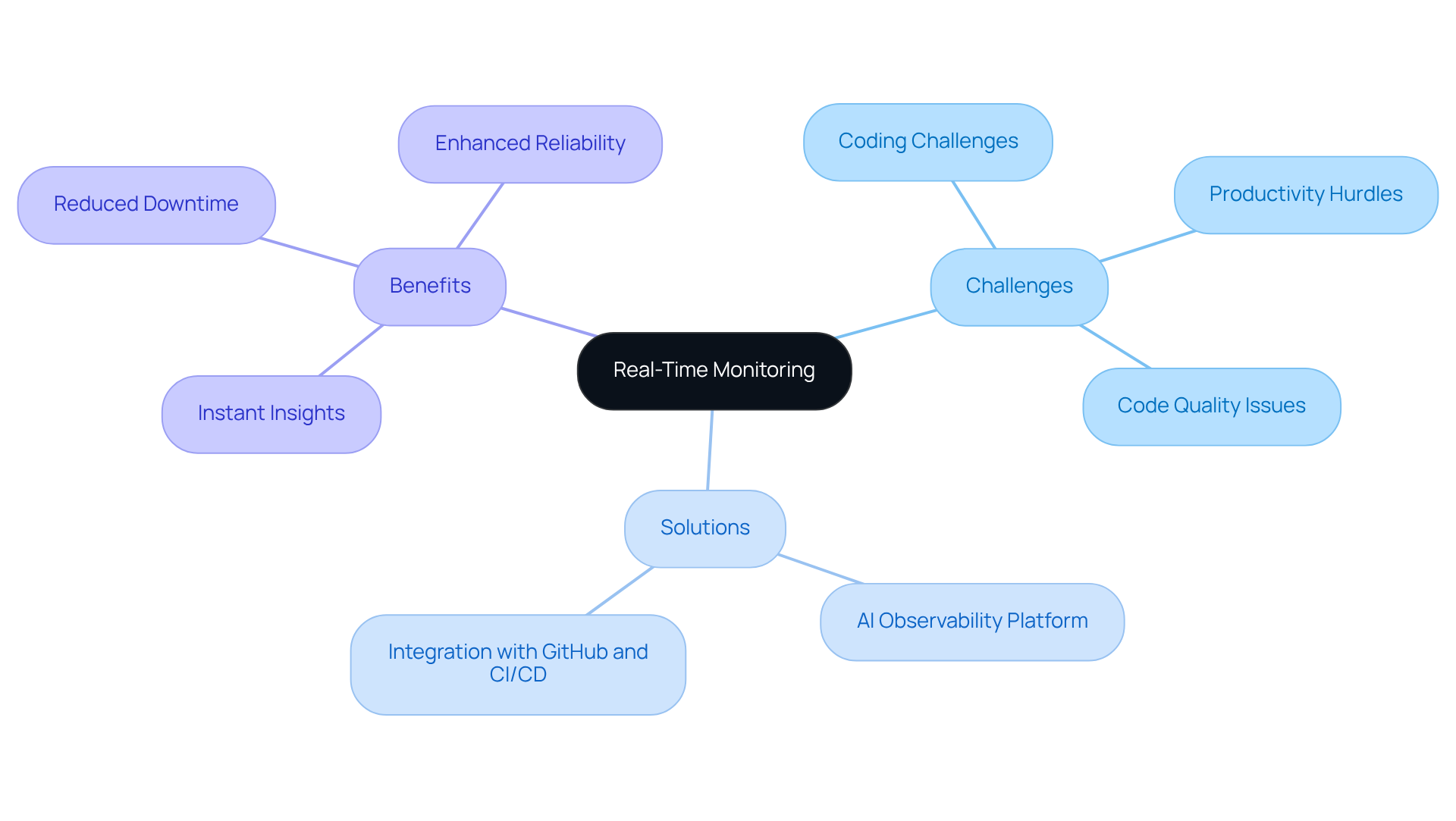
Comprehensive Data Collection: Gathering Metrics, Logs, and Traces
A robust AI observability platform is essential for addressing the myriad challenges developers face in monitoring their systems. It must collect a wide array of information, including metrics, logs, and traces. This thorough information gathering allows teams to examine operational behavior in detail, promoting improved decision-making and more efficient problem-solving.
Furthermore, by linking various information types, organizations can gain deeper insights into the performance and health of their AI observability platform. This capability not only enhances operational efficiency but also supports better strategic planning.
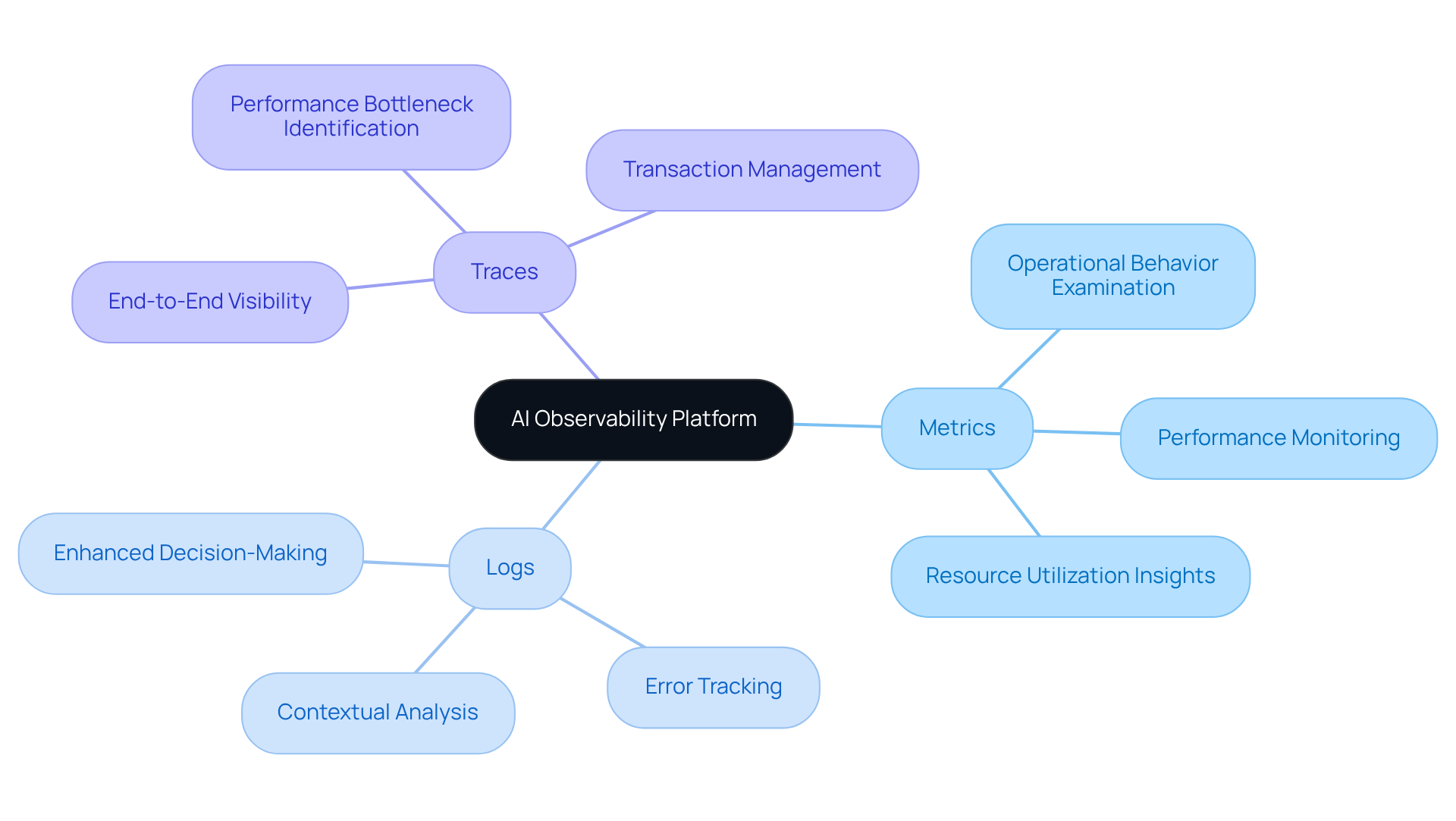
Intelligent Alerts: Proactive Notifications for Anomaly Detection
Smart alerts are essential in an AI observability platform, providing proactive notifications regarding anomaly detection, which enables teams to address potential issues before they escalate and affect performance. How can organizations leverage these tools effectively? By employing advanced machine learning algorithms that utilize 60 days of historical data for training and testing models, smart alerts can prioritize notifications based on severity and relevance. This approach significantly reduces alert fatigue, a common challenge faced by approximately 70% of monitoring teams, allowing engineers to concentrate on the most critical incidents.
Firms like Twilio and Dynatrace exemplify the successful implementation of proactive notifications. They utilize smart alert mechanisms that adjust thresholds dynamically based on historical data and real-time analysis. For instance, Twilio's smart alerts reduce the need for manual alarm setups and provide real-time notifications, ensuring timely and relevant alerts that enhance overall reliability and performance. Furthermore, as Bashyam Anant from Sumo Logic points out, the use of an AI observability platform not only diminishes alert noise but also expedites incident diagnosis and recovery time. This fundamentally transforms the way organizations troubleshoot and secure their applications and infrastructure.
Are you ready to embrace smart alert systems to improve your operational efficiency? The integration of these advanced tools can significantly enhance your team's ability to respond to incidents swiftly and effectively.
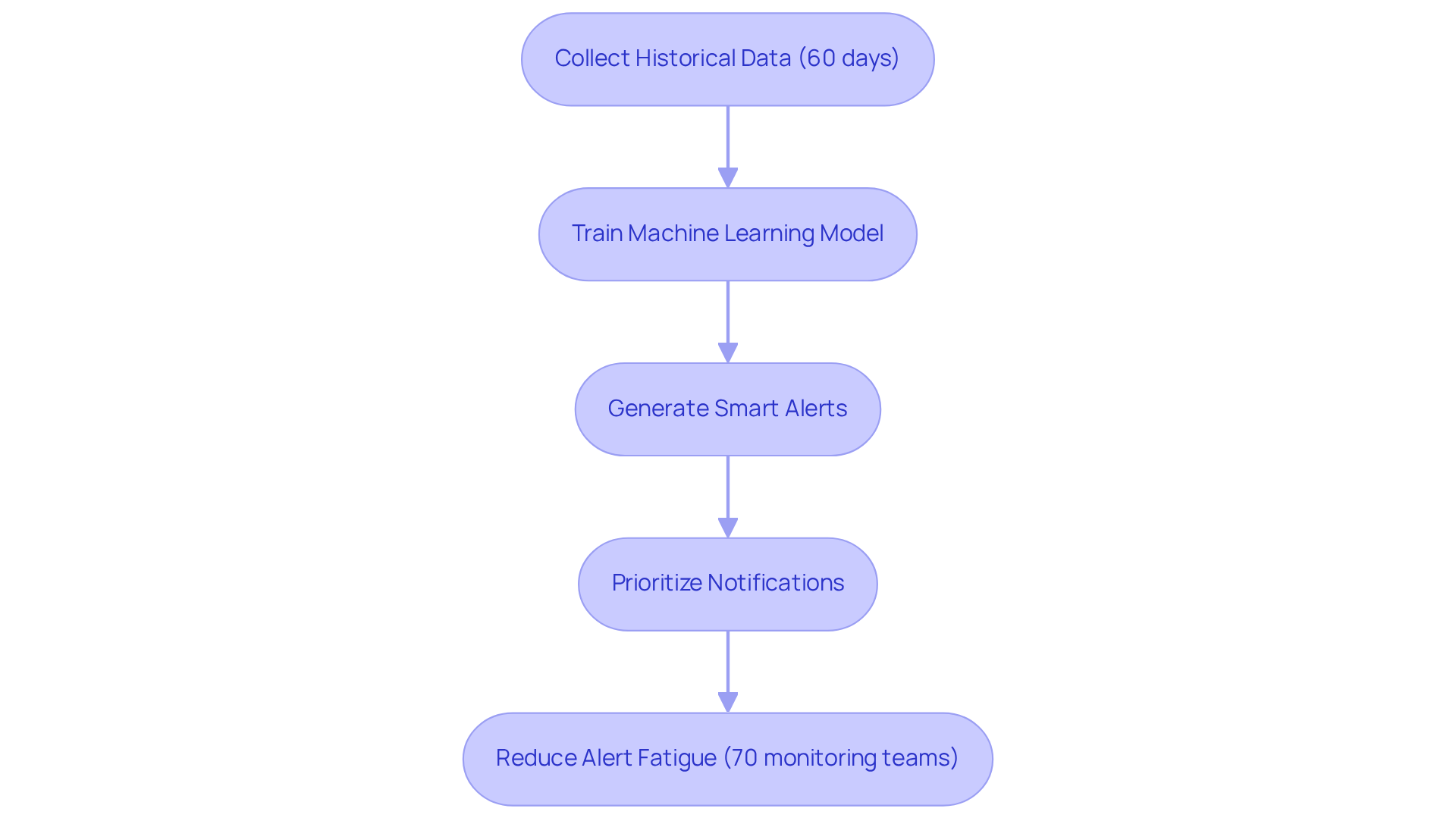
Root Cause Analysis: Identifying and Resolving Issues Quickly
Coding challenges are a common hurdle for developers, particularly when it comes to identifying and resolving issues within AI frameworks. Effective root cause analysis tools play a crucial role in promptly addressing these problems. By utilizing data patterns and examining operational behavior, Kodezi can precisely identify the root causes of failures. This targeted approach not only facilitates swift remediation efforts but also significantly enhances overall system stability and performance.
How does Kodezi address these challenges? Organizations employing a sophisticated AI observability platform benefit from features such as automated code debugging, which quickly detects and resolves issues in the codebase. These tools provide comprehensive explanations of failures and their solutions, making the debugging process more efficient. Furthermore, the platform excels in resolving performance bottlenecks, detecting security issues, and improving code formatting to ensure adherence to the latest coding standards—an essential factor in today’s fast-paced environments.
What sets Kodezi apart from its rivals? Unlike competitors, Kodezi emphasizes functioning as an autocorrect for code rather than simply autofilling, which facilitates a more comprehensive debugging process. In addition, the AI-driven automated builds and testing from the platform enhance code quality, allowing teams to shorten project completion times and boost productivity.
To fully optimize the advantages of such observability solutions, organizations should routinely assess their code and leverage the features of the AI observability platform provided by Kodezi. By doing so, they can sustain resilient AI frameworks and ultimately improve their development processes.

User-Friendly Dashboards: Visualizing AI Performance Metrics
User-friendly dashboards are essential in an AI observability platform for visualizing AI performance metrics, enabling teams to easily monitor operational health and performance. These dashboards can be tailored to showcase pertinent information, which aids stakeholders in grasping behavior more clearly. By offering real-time insights, they empower teams to make swift, informed decisions, ultimately boosting operational efficiency and responsiveness.
The ability to present complex information in an accessible format is crucial for tracking AI systems with an AI observability platform, ensuring that potential issues are identified and addressed proactively. Furthermore, recent trends highlight the emergence of self-healing dashboards, which automatically detect and rectify data inconsistencies, thereby enhancing reliability. This advancement in dashboard technology emphasizes the significance of integrating AI capabilities with human expertise to achieve optimal results.
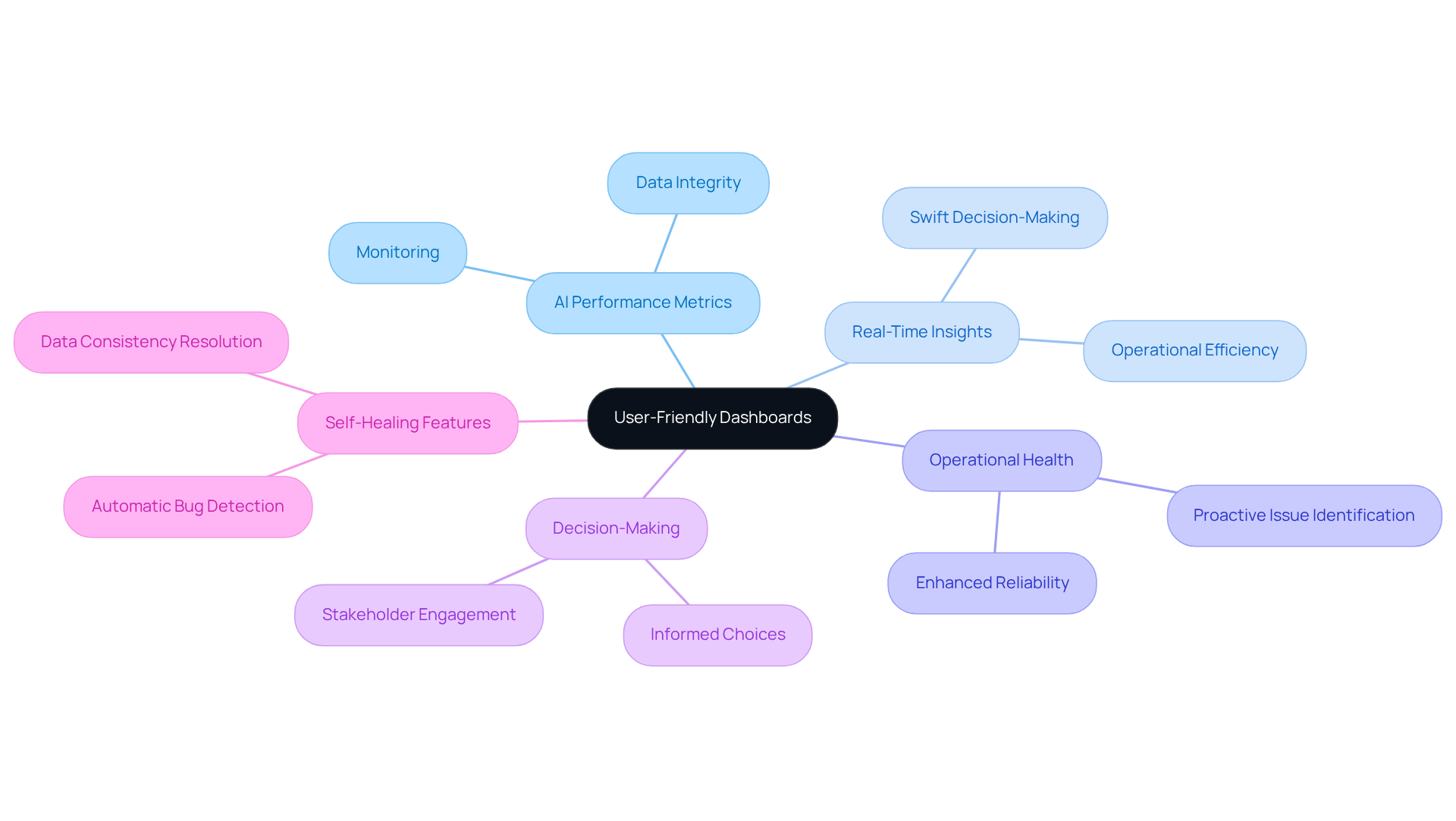
Integration Capabilities: Connecting with Existing Tools and Workflows
Integration capabilities are crucial for monitoring platforms, facilitating seamless connections with existing tools and workflows. Have you ever faced challenges in maintaining productivity due to disjointed systems? By ensuring compatibility with popular development environments and CI/CD pipelines, these platforms significantly enhance productivity and streamline processes. For instance, teams that employ CI/CD pipelines incorporating monitoring tools report enhanced deployment frequencies and shortened lead times. Some organizations experience deployment rates up to 200 times quicker and recover from issues 24 times faster. This integration allows teams to maintain a steady flow of new features and bug fixes while minimizing disruptions to established workflows.
Furthermore, as Alexandre Walsh, Co-Founder and Head of Product at Axify, notes, 'Tracking and acting on your CI/CD metrics keeps your pipeline healthy and allows you to stay ahead in the fast-paced world of software development.' In addition, by utilizing monitoring tools within CI/CD frameworks, organizations can cultivate a culture of continuous improvement. Each deployment becomes a valuable opportunity to learn and develop, ensuring that teams are always advancing. Explore how integrating these tools can transform your development processes and lead to significant efficiency gains.
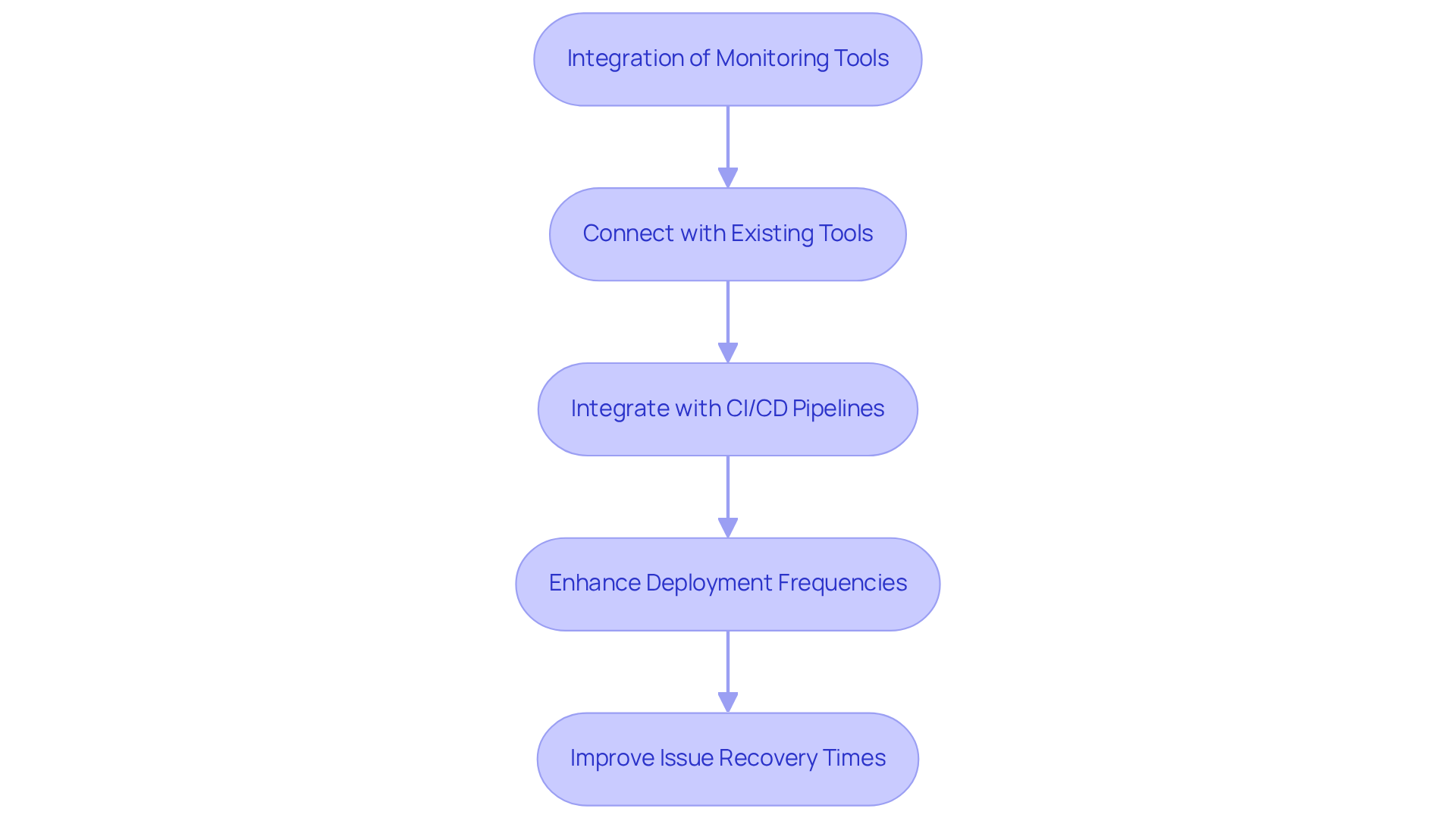
Scalability: Adapting to Growing AI System Complexity
Scalability is a crucial feature of the AI observability platform, allowing it to adapt to the growing complexity of AI systems. As organizations expand their operations and integrate more sophisticated technologies, it is essential for monitoring tools to evolve accordingly. This adaptability ensures that effective oversight and analytical capabilities are maintained, allowing organizations to keep pace with their technological advancements.
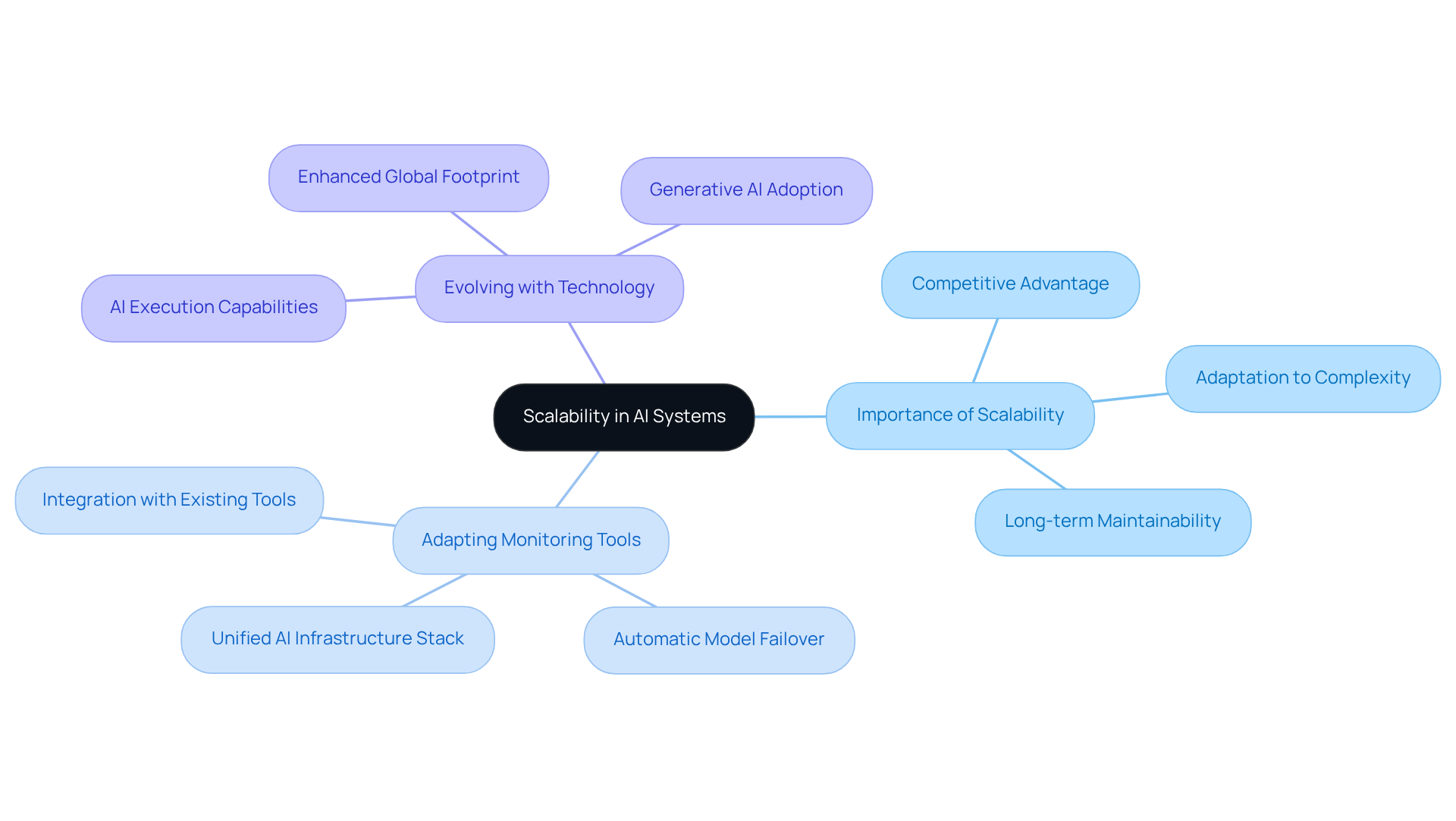
Security Features: Safeguarding Data and Ensuring Compliance
In AI observability platforms, security features are crucial as they protect sensitive information and ensure compliance with industry regulations. How can organizations safeguard against breaches and unauthorized access? By applying robust security protocols, the AI observability platform ensures the integrity and reliability of AI systems. Organizations must effectively manage the capture, processing, storage, and access to sensitive details to comply with regulations like GDPR and HIPAA. This becomes especially vital in complex IT environments where large volumes of monitoring data are generated.
Furthermore, the AI observability platform automates oversight processes, enabling organizations to address potential issues in real-time. This not only enhances operational efficiency but also supports compliance efforts. As organizations increasingly depend on data to inform their decisions, the need for comprehensive security measures in monitoring tools becomes even more pressing. Are your current monitoring tools equipped to handle these challenges?
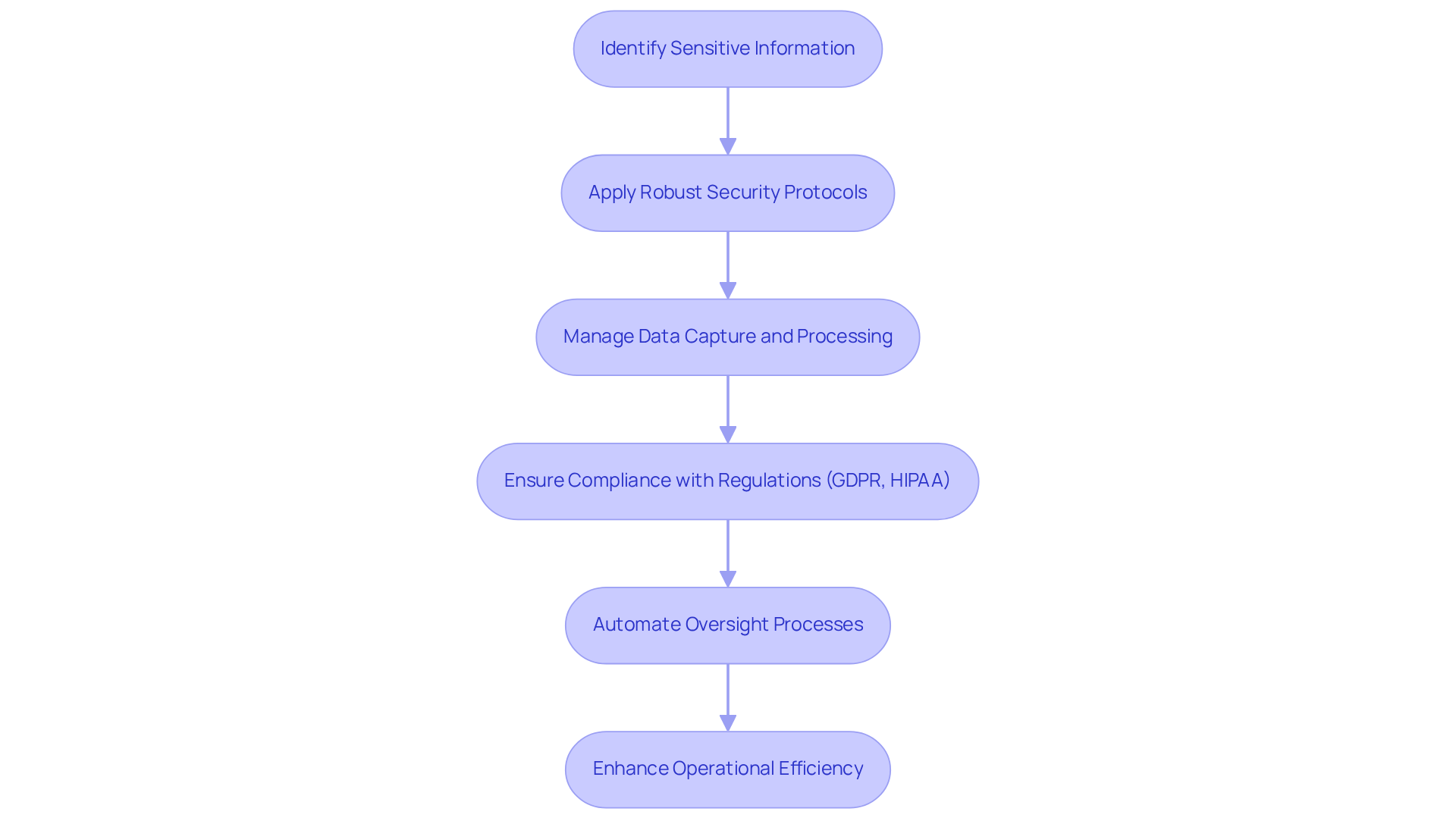
Automated Remediation: Swift Fixes for Detected Issues
Coding challenges can be a significant hurdle for developers. Automated remediation capabilities empower the AI observability platform to swiftly tackle detected issues without requiring human intervention. Kodezi addresses these challenges by implementing fixes for common problems automatically, which can lead to a substantial reduction in downtime—often achieving an average reduction of up to 50% in service interruptions, as evidenced in various industry applications. This efficiency not only enhances overall system reliability but also allows engineering teams to focus on strategic initiatives rather than routine troubleshooting.
For instance, the CLI autonomously enhances code quality by addressing vulnerabilities and applying patches in real-time. It provides detailed explanations and insights into what went wrong and how it was resolved, ensuring that security threats are mitigated before they escalate. Furthermore, features such as automated code debugging, bug healing, and documentation synchronization exemplify how automated fixes can lead to a more resilient infrastructure. This ultimately improves user experience and operational efficiency.
Are you ready to enhance your AI observability platform? Integrate Kodezi's automated remediation strategies today to experience improved productivity and code quality.

Conclusion
The significance of an AI observability platform is paramount, as it serves as a vital tool for enhancing the performance and reliability of AI systems. In today's fast-paced development environment, organizations face numerous coding challenges. How can they effectively address these complexities? By integrating features such as real-time monitoring, comprehensive data collection, and automated remediation, teams can ensure their AI frameworks operate at peak efficiency.
Key insights from the article underscore the necessity of intelligent alerts for proactive anomaly detection. User-friendly dashboards visualize performance metrics, while robust security features safeguard sensitive data. Furthermore, the integration capabilities of these platforms streamline workflows and enhance productivity. With scalability, organizations can adapt to the growing demands of AI technology. Each of these elements contributes to a cohesive strategy that empowers teams to maintain high-quality standards and respond swiftly to challenges.
In a rapidly evolving technological landscape, embracing the essential features of an AI observability platform is crucial for any organization looking to stay competitive. By leveraging the tools and strategies discussed, teams can foster a culture of continuous improvement. They can enhance operational efficiency and ultimately drive better outcomes in their AI initiatives. The time to invest in these capabilities is now—transform coding practices and elevate software development to new heights.
Frequently Asked Questions
What is Kodezi and what does it do?
Kodezi is a professional OpenAPI specification generator that functions as an autonomous codebase maintenance tool. It automates code debugging and ensures that code remains clean, compliant, and production-ready over time.
What are the main features of Kodezi?
Kodezi offers several robust features, including automated code debugging, automatic generation of OpenAPI 3.0 specifications, and Swagger UI for API documentation and testing.
How does Kodezi improve productivity and code quality?
By ensuring that code is consistently clean and compliant, Kodezi helps teams significantly improve productivity and maintain high-quality software standards.
What role does real-time monitoring play in Kodezi?
Real-time monitoring provides instant insights into AI performance, allowing teams to quickly identify anomalies and performance issues, which enhances operational efficiency and reduces downtime.
How does Kodezi integrate with other tools?
Kodezi can be integrated with tools like GitHub and CI/CD pipelines, enabling organizations to leverage an AI observability platform for optimal AI system performance.
What benefits do companies experience by using Kodezi?
Companies using Kodezi have reported significant improvements in response times, with tech firms experiencing average reductions of up to 30%, leading to enhanced performance and productivity across various programming languages and IDEs.
Why is comprehensive data collection important in Kodezi?
Comprehensive data collection, including metrics, logs, and traces, allows teams to examine operational behavior in detail, leading to improved decision-making and more efficient problem-solving.
How does Kodezi support strategic planning?
By linking various information types, Kodezi provides deeper insights into the performance and health of AI systems, which enhances operational efficiency and supports better strategic planning.




